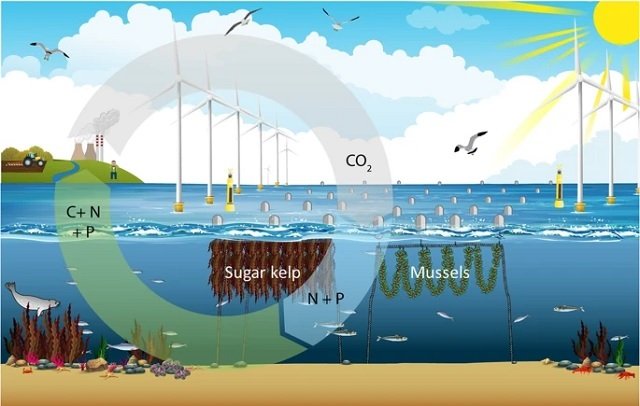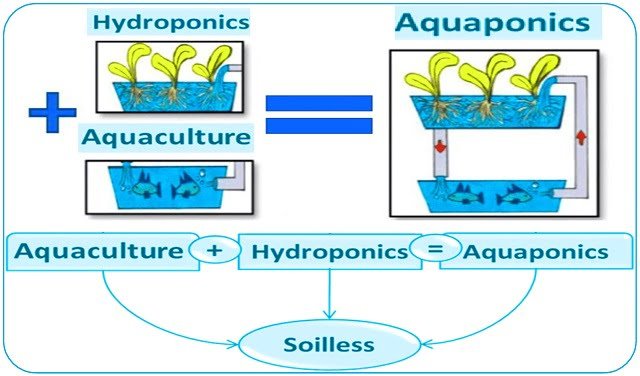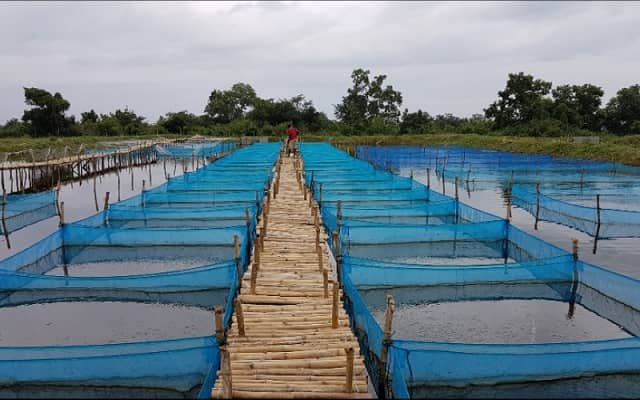
The future of sustainable development in the blue economy requires efficient use of marine space, relying on innovative solutions that address multiple challenges simultaneously.
One promising approach combines offshore wind farms (OWF) with low trophic level aquaculture (LTA), offering mutual benefits for energy production, food security, and environmental health.
Scientists from Aarhus University, the University of Copenhagen, the University of Applied Sciences Bremerhaven, and the University of Tartu explored and modeled the OWF-LTA concept on a regional and global scale, aiming to contribute to sustainable development goals. They utilized data from the North Sea – Baltic Sea transition zone.
Experiences from Low Trophic Level Aquaculture in Open Seas
The study cites several projects in Northern Europe that have modeled and assessed whether low trophic level aquaculture in open seas can be combined with OWF in the same areas.
Feasibility studies have shown that the multi-use of OWF combined with blue mussel (Mytilus spp.) and sugar kelp (Saccharina latissima) aquaculture has high potential in the North Sea.
“The expansion of OWF-LTA on a commercial scale depends on technological readiness, production potential, environmental conditions, economic viability, permits and regulations, and operational challenges caused by the interaction of two or more co-uses, requiring joint efforts in risk governance,” the study states.
Multiple Uses for Triple Benefits
“This study demonstrates great potential for such innovation; the multiple uses of OWF-LTA in the North Sea to Baltic Sea transition zone to promote optimal and more sustainable use of marine space,” report the researchers.
They used these experiences to make regional and global projections of OWF-LTA to highlight the global potential and benefits of multiple oceanic space uses and discuss developments necessary for future offshore multiple uses to provide restorative ecosystem services (ESS).
Stay Always Informed
Join our communities to instantly receive the most important news, reports, and analysis from the aquaculture industry.
This novel strategy integrates wind turbines with the cultivation of organisms like mussels and algae, generating multiple benefits:
- Sustainable Energy: Offshore wind farms harness the power of the wind to generate clean energy, contributing to the global transition away from fossil fuels.
- Nutritious Seafood and Algae: Aquaculture provides a sustainable source of proteins and vital nutrients for a growing population. Mussels and algae are particularly efficient producers, requiring minimal inputs and offering significant nutritional value.
- Restorative Ecosystem Services: Mussels filter water, remove contaminants, and improve water quality. Seaweed absorbs carbon dioxide, mitigating climate change and promoting ocean sequestration.
Global Impact Potential
According to the researchers, “The ambitious development of OWF in the study area combined with multi-use LTA is a pioneering approach that can be transferred to other regions of the world with existing or projected OWF, selecting the most suitable sites and local species for cultivation.”
Research suggests that allocating only 10% of projected areas for large-scale wind farms to mussel and algae farms in specific transition zones could yield substantial benefits. In the North Sea to Baltic Sea transition zone, this translates to a potential harvest of 18 tons of fresh algae and mussels per hectare annually.
Even more impressive is that the captured and harvested carbon from this biomass could equate to 40% of Danish agricultural sector carbon dioxide emissions. This underscores the significant potential of multiple-use systems to address climate change.
Global Food Security
According to global projections for seven regions, marine low trophic level aquaculture production can increase by 132% in the realistic scenario; however, in the optimistic scenario, production could grow by 400%.
Northern Europe showed the highest potential for OWF-LTA development among the evaluated regions.
Challenges and Opportunities
While the potential of multiple-use marine platforms is enormous, there are technological and regulatory obstacles to overcome. Research is needed to develop optimal systems for integrating aquaculture with wind farms, ensuring efficient operation and minimal environmental impact. Clear regulatory frameworks are also crucial to facilitate the development and implementation of this innovative approach.
Conclusion
The multiple use of offshore wind farms with low trophic level aquaculture presents a compelling solution to achieve multiple UN Sustainable Development Goals. By generating clean energy, providing nutritious food, and promoting environmental health, this strategy has the potential to revolutionize resource utilization and contribute to a more sustainable future.
As research continues and regulatory frameworks evolve, this promising approach is poised to reshape how we manage our oceans and resources, fostering a sustainable future for generations to come.
This study has been funded by the European Union’s Horizon 2020 innovation program and the Danish Velux Foundation WIN@sea.
Contact
Marie Maar
Department of Ecoscience
Aarhus University
Frederiksborgvej 399, 4000, Roskilde, Denmark
Email: mam@ecos.au.dk
Referencia (acceso abierto)
Maar, M., Holbach, A., Boderskov, T. et al. Multi-use of offshore wind farms with low-trophic aquaculture can help achieve global sustainability goals. Commun Earth Environ 4, 447 (2023). https://doi.org/10.1038/s43247-023-01116-6
Editor at the digital magazine AquaHoy. He holds a degree in Aquaculture Biology from the National University of Santa (UNS) and a Master’s degree in Science and Innovation Management from the Polytechnic University of Valencia, with postgraduate diplomas in Business Innovation and Innovation Management. He possesses extensive experience in the aquaculture and fisheries sector, having led the Fisheries Innovation Unit of the National Program for Innovation in Fisheries and Aquaculture (PNIPA). He has served as a senior consultant in technology watch, an innovation project formulator and advisor, and a lecturer at UNS. He is a member of the Peruvian College of Biologists and was recognized by the World Aquaculture Society (WAS) in 2016 for his contribution to aquaculture.




